|
The 2008 State of the Dome Address by Mark C. Petersen, Loch Ness Productions A presentation for the Fulldome Summit, Chicago, Illinois, 3 July 2008 © 2008, Loch Ness Productions |
| Abstract. As perspective for pondering the future of fulldome as a medium and market, it might be useful to review its current state. Statistics drawn from Loch Ness Productions' LNP FULLDOME THEATER COMPENDIUM ONLINE! are presented and discussed, and provide some answers to the quintessential questions: "Who are we, where are we, and what are we doing?" |
(2011 note: presentation edited to make active links of referenced Web resources.)
Since 2004, I've maintained data on every fulldome theater in the world I find out about, and make a listing available on the Loch Ness Productions Web site. It's called the LNP FULLDOME THEATER COMPENDIUM ONLINE! and you can access it directly at this URL:
www.lochnessproductions.com/lfco/lfco.html
There is the usual address and contact information, dome sizes, seating arrays, projector systems, and attendance reports. And there are many other features, such as Skype-able phone numbers and fulldome projector manufacturer links. The raw data is all there.
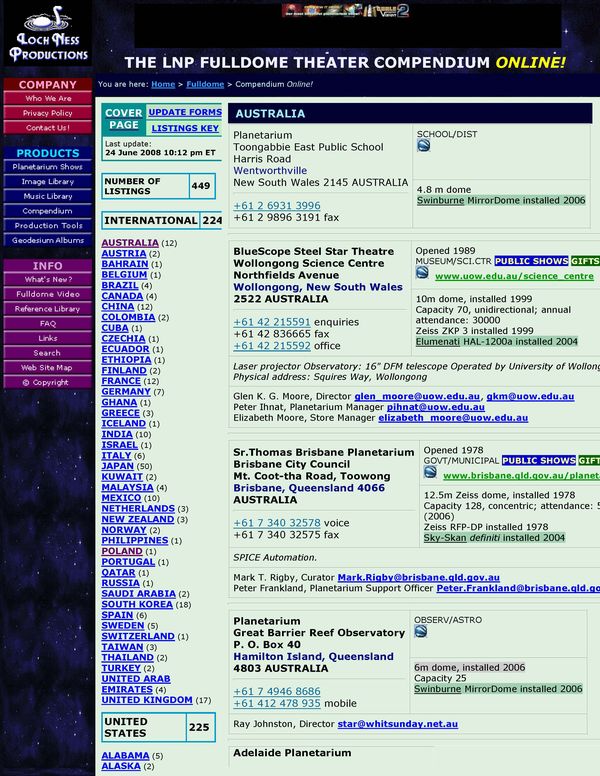
There aren't any summaries of the data online (that's a feature included in our commercial product). But, anyone dedicated enough could comb through the pages and compile summaries themselves. I've done that for this presentation, to create a "snapshot view" of the online listings as they existed on 28 June 2008. Of course, the numbers constantly change as I receive updates provided by theater operators, vendors, news updates, and customers. Last year for DomeFest 2007, I did a similar data analysis, and I'll compare those numbers with this year's tallies.
There is one "summary" feature visible online: the total number of listings. As of 28 June 2008, I list 449 entries. That's up from the 276 theater entries from 2007. There's an even split — half are in the U.S., and the other half are in the all the rest of the countries of the world combined. So I've kept track of American figures separately from the international numbers.

Looking at the some of the summary tables, we see that — in terms of number and size of domes — larger domes predominate internationally, while mid-size domes are more plentiful in the U.S. More seating configurations are front-facing, compared to concentric seating (though there's a large "unknown" factor here). The overwhelming majority of theaters are associated with some form of educational or cultural institution, which is significant if you are a show producer evaluating fulldome as a "market".
I included an "Annual Attendance Projection" — but there are many, many caveats with regard to this 26 million number. I explain them and the methodology used to estimate this figure on these Web pages:
www.lochnessproductions.com/pltref/attend.html
www.lochnessproductions.com/pltref/more_attend.html
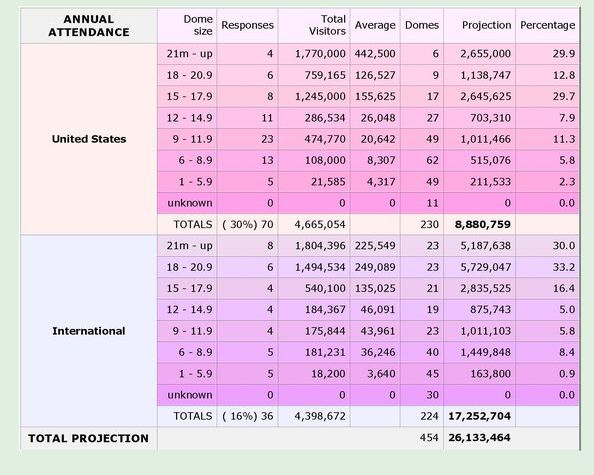
I tallied the number of projector systems in the listings (note that several theaters have more than one fulldome system). I counted 498 this year, up from 316 last year. Of those, 58% are the single-projector systems, usually with 1K resolution or less. In other words, in the fulldome world, the little guys are the biggies.

Then, I sorted the projector systems by their makers to get an idea of whose systems are the most popular.
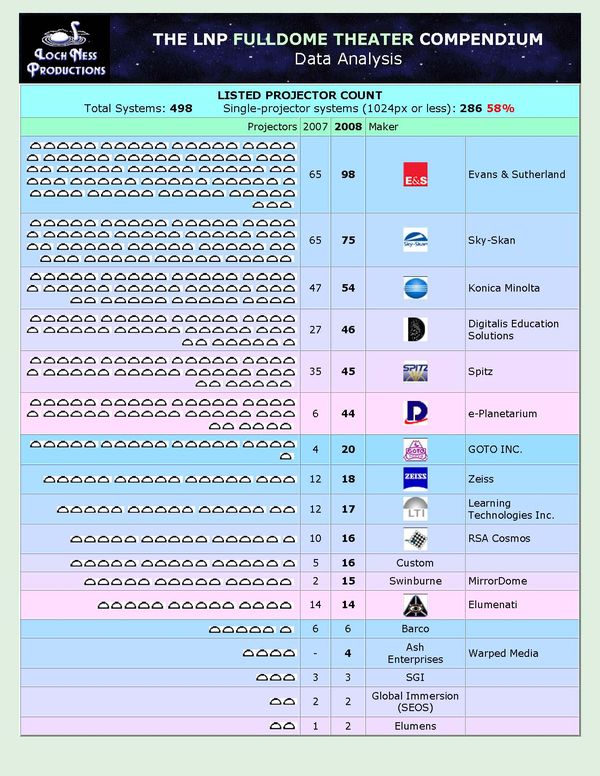
It should come as no surprise to anyone in the field to note that Evans & Sutherland (E&S) and Sky-Skan are battling it out at the top. If you want to think of my listing of installations as a horse race, in 2007 the two companies were neck-and-neck; this year E&S appears to have pulled ahead by a length or two.
The validity for the numbers for the major hardware manufacturers should be pretty good; they often provide such information either on their own Web sites, or directly to me. However, with the portables — not so much. While ePlanetarium posts their customer installations on their Web site, Digitalis Education Solutions and Learning Technologies Inc. have policies about not releasing their customer information. However, the folks from Digitalis have told me that there are more than a hundred systems out there that I don't have address information for, and anecdotally, I've been told the number of Digital StarLabs could be triple what I list. If you take these unlisted system counts into consideration, the total number of systems goes to more than 600. They're all "1K or less" systems, so it makes that category jump to nearly 75%. Stated more obviously, three out of four fulldome systems today have a maximum of 1K resolution.
I should mention that I do include portables in the LNP FULLDOME THEATER COMPENDIUM ONLINE! although it may be an interesting discussion point about whether an inflatable dome qualifies as a "theater". That's a philosophical debate for another time, however. From Loch Ness Productions' viewpoint, if a system can show our fulldome videos on its dome, it counts as a theater!
So, what are people showing in their domes? Since we include Web sites in the Compendium listings, I surfed them — starting at the top, from A to Z. I simply went to every fulldome theater's site, looked for their show listings and noted the results. It only took several days to do...
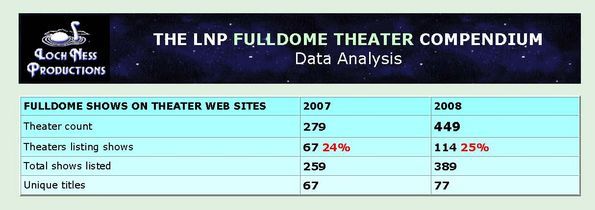
Of what I consider profound significance: many of the Web searches for shows turned up nothing. In fact, only on 25% of the sites could I find program offerings. One could deduce that three out of four fulldome theaters do not present commercially-produced fulldome videos to the general public. Or, perhaps they don't want people to know what they're showing. Or, maybe they only give live presentations using their fulldome systems software interactively. For judging a potential market for programs, though, this should give people pause for thought.
This year, I found 114 theater Web sites that did list shows. Some list only the "current feature"; while others apparently list every show they're ever bought. One cannot easily judge "what's hot and what's not" for show titles from such listings, and one needs to keep in mind that my count is just a snapshot of the state of these Web pages in June 2008. For example, you won't find many mentions of Christmas/winter holiday shows in the middle of summer.
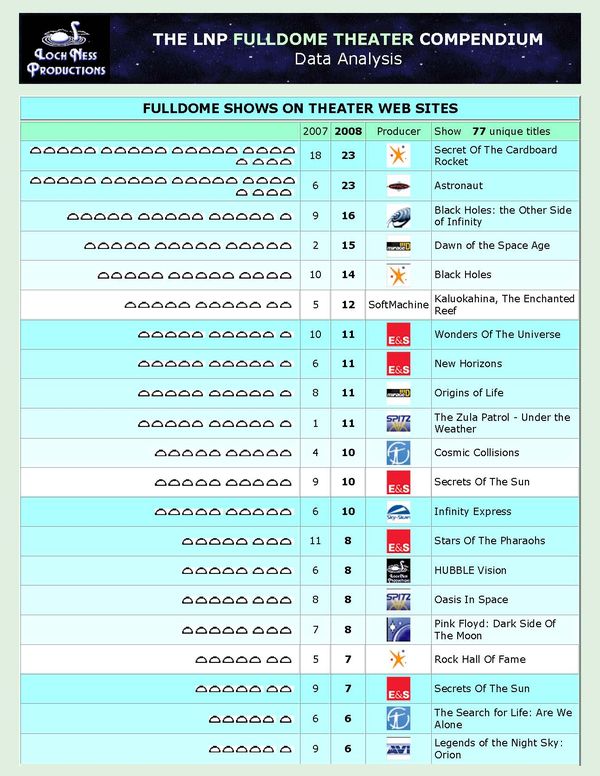
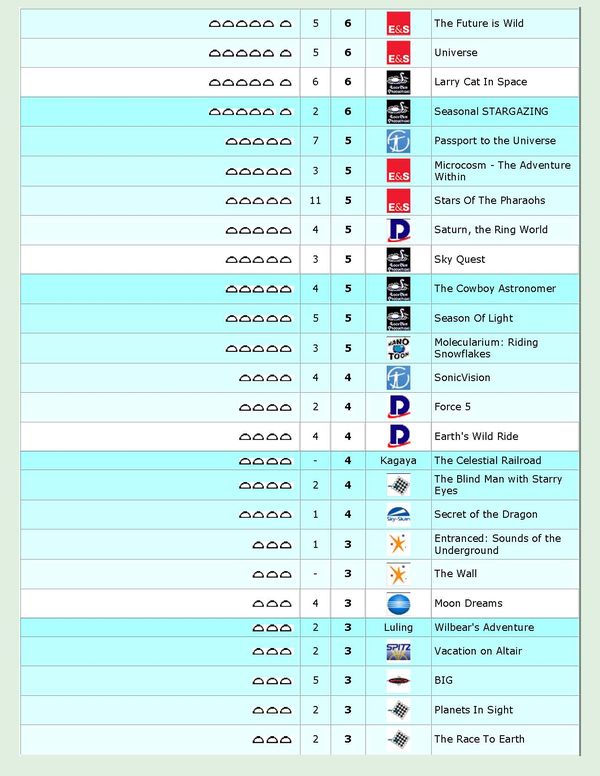
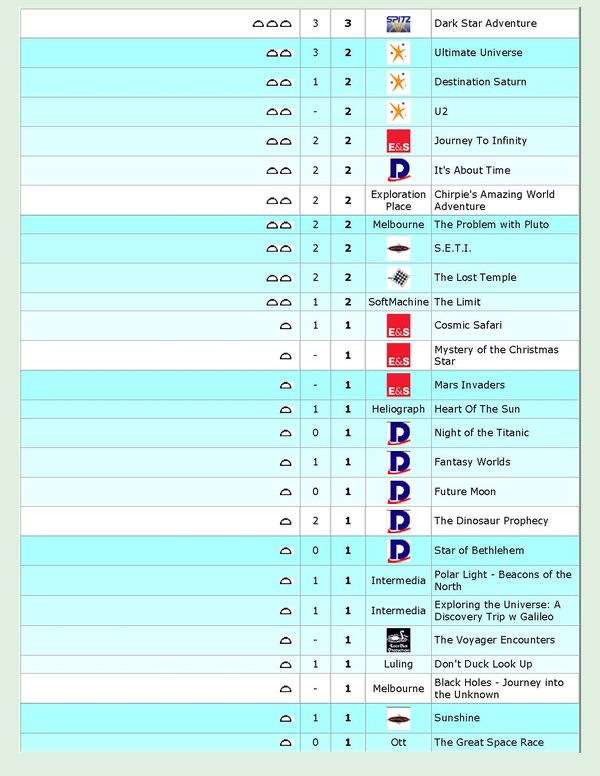

Last year, the most frequently mentioned show was Clark Planetarium's "Secret Of the Cardboard Rocket." In June 2008, the most frequently mentioned show was Clark Planetarium's "Secret Of the Cardboard Rocket" — but, it tied with National Science Centre's "Astronaut" this time around.
As I did with the projector systems, I then sorted the show titles by producer.
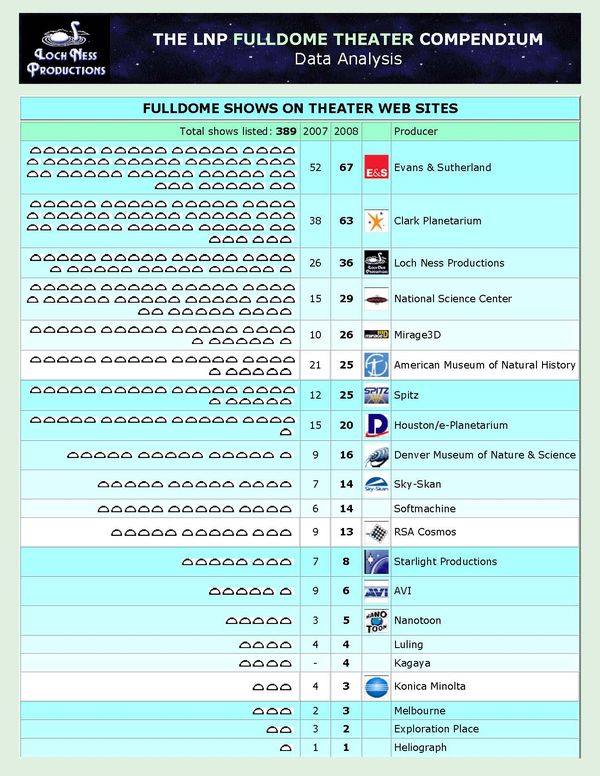

No surprise here either; since E&S offers the most titles, they have the most shows listed, followed by Clark, then — Loch Ness Productions! Hooray, we're #3! Now, I know how many Loch Ness Productions shows we've distributed, and it's a lot more than the 36 I found mentioned on Web sites in July. If I used our real numbers instead, then... we're #1! Of course, everyone else's real numbers would probably also rise. I also don't have figures that compare shows sold to shows being shown. Of interest is how much influence Salt Lake City has on fulldome content; more shows come from the top two Utah producers than the next four companies combined!
I found 77 unique show titles mentioned. That's almost as many as total number of show titles commercially available to my knowledge — 96 is my count.

Finally, I should mention a feature of the Compendium on which I've worked particularly hard. I've included latitude and longitude location data for each theater, and you can select the Google Earth link in the listing to go there using that application. You can also download the FULLDOME.KML file — which has Placemarks for every theater on the globe. I noticed SCISS used this KML file used during their Uniview demonstration. While they did credit "the Compendium" during their presentation, I hope they'll mention Loch Ness Productions as the creator next time!


